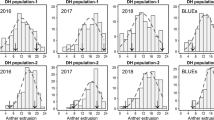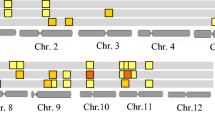Abstract
Anther culture is the most effective tool for doubled haploid production of wheat. This investigation was conducted to estimate genetic parameters of anther culture response in wheat and identification of putative Quantitative trait loci (QTLs) associated with response traits. Two varieties of wheat, namely ICR-DH (P1) and Sle 1 × 15 (P2) and their F1 and F2 progenies were used in the present investigation to estimate genetic parameters of anther culture response. Two molecular marker systems, SRAP and SSR markers were used to detect the polymorphism between two anther donor parents. Single marker analysis (SMA) and Composite interval mapping (CIM) were used to localize the putative QTL associated with four anther culture response in wheat using 100 plants of F2 population derived from F1 cross ‘ICR-DH’ × ‘Sel 1 × 15’. Analyses of variance indicated significant differences between four populations (P1, P2, F1 and F2) for callus induction (CAL), number of green plants per 100 anther (GR), number of albino plant per 100 anther (AR) and total regenerated plants per 100 anther (TR). The additive effects were more important than dominance effects in controlling these traits. The two molecular marker systems were sufficient in detecting polymorphism between two parents. Thirty two putative QTLs were detected on eight linkage groups. Our study indicated that the additive effects of genes and detection of new QTLs permit marker-assisted selection of genotypes with high green plantlet regeneration efficiency in anther culture, and therefore favor efficient use of anther culture in wheat breeding programs


Similar content being viewed by others
References
Seguí-Simarro JM (2010) Androgenesis revisited. Bot Rev 76:377–404. https://doi.org/10.1007/s12229-010-9056-6
Henry Y, de Buyser J (1990) Wheat anther culture agronomic performance of doubled haploid lines and the release of a new variety “Flory.” In: Bajaj YPS (ed) Biotechnology in agriculture and forestry, vol 13. Springer, Berlin, pp 285–352
Tuvesson S, Ljungberg A, Johansson N, Karlsons KE, Suijs LW, Josset JP (2000) Large-scale production of wheat and triticale double haploids through the use of a single-anther culture method. Plant Breed 119:455–459
Tuvesson IK, Pedersen S, Andersen SB (1989) Nuclear genes affecting albinism in wheat (T. aestivum L.) anther culture. Theor Appl Genet 78:879–883
Weigt D, Kiel A, Siatkowski I, Zyprych-Walczak J, Tomkowiak A, Kwiatek M (2020) Comparison of the androgenic response of spring and winter wheat (Triticum aestivum L.). Plants 9(49):1–12
Jing JK, Xi ZY, Hu H (1982) Effects of high temperature and physiological conditions of donor plants on induction of pollen derived plants in wheat. Annual reports of institute of genetics. Academia Sinica, Beijing, pp 64–68
Lazar MD, Baenziger PS, Schaeffer GW (1984) Cultivar and cultivar × environment effects on the development of callus and polyhaploid plants from anther cultures of wheat. Theor Appl Genet 67:273–277
Moieni A, Sarrafi A (1997) Genetic improvement of androgenetic haploid formation in hexaploid wheat (T. aestivum L.). Cereal Res Commun 25:15–20
Szakacs E, Kovács G, Pauk J, Barnabás B (1989) Substitution analysis of callus induction and plant regeneration from anther culture in wheat (Triticum aestivum L.). Plant Cell Rep 7:127–129
Sesek S, Dencic S (1996) The potential of anther culture technique in wheat breeding. Cereal Res Commun 24:163–170
Andersen SB, Due IK, Olesen A (1987) The response of anther culture in a genetically wide material of winter wheat (T. aestivum L.). Plant Breed 99:181–186
Knudsen S, Due IK, Andersen SB (1989) Components of response in barley anther culture. Plant Breed 103:241–246. https://doi.org/10.1111/j.1439-0523.1989.tb00378.x
Guiderdoni E, Galinato E, Luistro J, Vergara G (1992) Anther culture of tropical japonica 9 indica hybrids of rice (Oryza sativa L.). Euphytica 62:219–224. https://doi.org/10.1007/bf00041756
Immonen S (1999) Androgenetic green plants from winter rye, Secale cereale L., of diverse origin. Plant Breed 118:319–322. https://doi.org/10.1046/j.1439-0523.1999.00381.x
Torp AM, Hansen AL, Andersen SB (2001) Chromosomal regions associated with green plant regeneration in wheat (Triticum aestivum L.) anther culture. Euphytica 119:377–387
Ćalić D, Bohanec B, Devrnja N, Milojević J, Tubić L, Kostić I, Zdravković-Korać S (2013) Impact of abscisic acid in overcoming the problem of albinism in horse chestnut androgenic embryos. Trees 27:755–762. https://doi.org/10.1007/s00468-012-0830-4
Lantos C, Bóna L, Boda K, Pauk J (2013) Comparative analysis of in vitro anther- and isolated microspore culture in hexaploid Triticale (9 Triticosecale Wittmack) for androgenic parameters. Euphytica 197:27–37. https://doi.org/10.1007/s10681-013-1031-y
Mosgova GV, Orlov PA, Shalygo NV, Tzukhanovets NL (2005) Possible albinism mechanisms in wheat anther culture. Proc Natl Acad Sci Belarus 5:77–80
Mosgova GV, Orlov PA, Shaligo NV (2006) Variation in evolutionary unstable regions of the chloroplast genome in plant obtained in anther culture of di-haploid wheat lines. Genetica 42:192–197
Al-Kaab DH, Hamdalla MSh, Dweikat IM, Al-Saedi NJ (2016) Estimation of the degree of diversity for some iraqi wheat varieties through ISSR, SRAP and RAPD markers. Am J Exp Agric 11(3):1–11
Abdel-Lateif KS, Hewedy OA (2018) Genetic diversity among Egyptian wheat cultivars using SCoT and ISSR markers. SABRAO J Breed Genet 50(1):36–45
Yadav S, Vijapura A, Dave A, Shah S, Memon Z (2019) Genetic diversity analysis of different wheat [Triticum aestivum (L.)] varieties using SSR markers. Int J Curr Microbiol Appl Sci 8(2):839–846
Al-doss AA, Elshafei AA, Moustafa KA, Barakat MN (2011) Comparative analysis of diversity based on morpho-agronomic traits and molecular markers in durum wheat under heat stress. J Biotechnol 10:3671–3681
Yano M, Sasaki T (1997) Genetic and molecular dissection of quantitative traits in rice. Plant Mol Biol 35:145–153
Torp AM, Andersen SB (2009) Albinism in microspore culture. In: Touraev A, Forster BP, Jain SM (eds) Advances in haploid production in higher plants. Springer, Berlin, pp 155–160
Krzewska M, Czyczyło-Mysza I, Dubas E et al (2012) Quantitative trait loci associated with androgenic responsiveness in triticale (9 Triticosecale Wittm.) anther culture. Plant Cell Rep 31:2099–2108. https://doi.org/10.1007/s00299-012-1320-2
Muñoz-Amatriaín M, Castillo AM, Chen XW, Cistué L, Vallés MP (2008) Identification and validation of QTLs for green plant percentage in barley (Hordeum vulgareL.) anther culture. Mol Breed 22:119–129. https://doi.org/10.1007/s11032-008-9161-y
Grosse BA, Deimling S, Geiger HH (1996) Mapping of genes for anther culture ability in rye by molecular markers. Vortr Pflanzenzüchtung 35:282–283
Bolibok H, Gruszczyńska A, Hromada-Judycka A, Rakoczy-Trojanowska M (2007) The identification of QTLs associated with the in vitro response of rye (Secale cereale L.). Cell Mol Biol Lett 12:523–535. https://doi.org/10.2478/s11658-007-0023-0
He DG, Ouyang JW (1984) Callus and plantlet formation from cultured wheat anthers at different developmental stages. Plant Sci Lett 33:71–79
Liu W, Zheng Y, Polle E, Konzak CF (2002) Highly efficient doubled-haploid production in wheat (Triticum aestivum L.) via induced microspore embryogenesis. Crop Sci 42:686–692
Zhuang JJ, Jia X (1983) Increasing differentiation frequencies in wheat pollen callus. In: Hu H, Vega MR (eds) Cell and tissue culture techniques for cereal crop improvement. Science Press, Beijing, pp 431–445
Steel RG, Torrie JM (1997) Principles and procedures of Statistics, 3rd edn. McGraw-Hill, New York
Pederson DG (1971) The estimation of heritability and degree of dominance from a diallel cross. Heredity 27:247–264
Murray MG, Thompson WF (1980) Rapid isolation of high molecular weight plant DNA. Nucleic Acids Res 8:4321–4325
Michelmore RW, Paran I, Kesseli RV (1991) Identification of markers linked to disease-resistance genes by bulked segregant analysis: a rapid method to detect markers in specific genomic regions by using segregating populations. Proc Natl Acad Sci USA 88(21):9828–9832
Lander ES, Green P, Abrahamson J, Barlow A, Daly MJ, Lincoln SE, Newburg L (1987) Mapmaker: an interactive computer package for constructing primary genetic linkage maps of experimental and natural populations. Genomics 1:174–181
Lincoln S, Daly S, Lander E (1992) Constructing genetic maps with MAPMAKER/EXP 3.0, 3rd edn. Whitehead Institute Technical Report, Cambridge, MA
Wang S, Basten CJ, Zeng ZB (2012) Windows QTL cartographer 2.5. Department of Statistics, North Carolina State University, Raleigh
Chaudhary HK, Dhaliwal I, Singh S, Sethi GS (2003) Genetics of androgenesis in winter and spring wheat genotypes. Euphytica 132:311–319
Al-Ashkar IM (2014) Genetic contribution of parental genotypes on anther culture response of bread wheat F1 hybrids. Middle East J Agric Res 3(3):472–478
Zhou H, Konzak CF (1992) Genetic control of green plant regeneration from anther culture of wheat. Genome 35:957–961. https://doi.org/10.1139/g92-146
Armstead IP, Turner LB, King IP, Cairns AJ, Humphreys MO (2002) Comparison and integration of genetic maps generated from F2 and BC1- type mapping populations in perennial ryegrass. Plant Breed 121:501–507
Ma J, Deng M, Si-Yu L, Yang Q, Qian-Tao J, Peng-Fei Q, Li W, Guo-Yue C, Xiu-Jin L, Yu-Ming W (2016) Identification of QTLs associated with tissue culture response of mature wheat embryos. SpringerPlus 5:1552. https://doi.org/10.1186/s40064-016-3241-y
Zhang LY, Sourdille P, Bernard M, Madeore A, Bernard S (2003) QTL mapping for anther culturability in wheat using a doubled-haploid population. In: Pogna NE, Romano M, Pogna EA, Galterio G (eds) Proceedings of the 10th international wheat genetic symposium. Paestum, Italy, pp 1078–1080
Anca MV, Andersen SB, Banga D, Ardelean M, Torp AM (2007) Genetic mapping of wheat 2BL chromosome using SSR markers. Bulletin USAMV-CN 64:1454–1459
Nielsen NH, Andersen SU, Stougaard J, Jensen A, Backes G, Jahoor A (2015) Chromosomal regions associated with the in vitro culture response of wheat (Triticum aestivum L.) microspores. Plant Breed 134:255–263
Galiba G, Kovacs G, Sutka J (1986) Substitution analysis of plant regeneration from callus culture in wheat. Plant Breed 97:261–263
Agache S, Bachelier B, De Buyser J, Henry Y, Snape J (1989) Genetic analysis of anther culture response in wheat using aneuploid, chromosome substitution and translocation lines. Theor Appl Genet 77:7–11
Collard BCY, Jahufer MZZ, Brouwer JB, Pang ECK (2005) An introduction to markers, quantitative trait loci (QTL) mapping and marker-assisted selection for crop improvement: the basic concepts. Euphytica 142(1–2):169–196
Acknowledgements
The authors would like to deeply appreciate the support provided by the Faculty of Agriculture, Assiut University, Egypt.
Author information
Authors and Affiliations
Contributions
Conceptualization of research (BES, MAS, SAS); Designing of the experiments (BES); Contribution of experimental materials (BES, MAS, SAS); Execution of field/lab experiments and data collection (BES, MAS); Analysis of data and interpretation (BES, MAS, SAS); Preparation of manuscript (BES, MAS).
Corresponding author
Ethics declarations
Conflict of interest
The authors declare that they have no conflict of interest.
Research involving human participants and/or animals
This article does not contain any studies with human participants or animals performed by any of the authors.
Additional information
Publisher's Note
Springer Nature remains neutral with regard to jurisdictional claims in published maps and institutional affiliations.
Rights and permissions
About this article
Cite this article
Abd El-Fatah, B.E.S., Sayed, M.A. & El-Sanusy, S.A. Genetic analysis of anther culture response and identification of QTLs associated with response traits in wheat (Triticum aestivum L.). Mol Biol Rep 47, 9289–9300 (2020). https://doi.org/10.1007/s11033-020-06007-z
Received:
Accepted:
Published:
Issue Date:
DOI: https://doi.org/10.1007/s11033-020-06007-z




